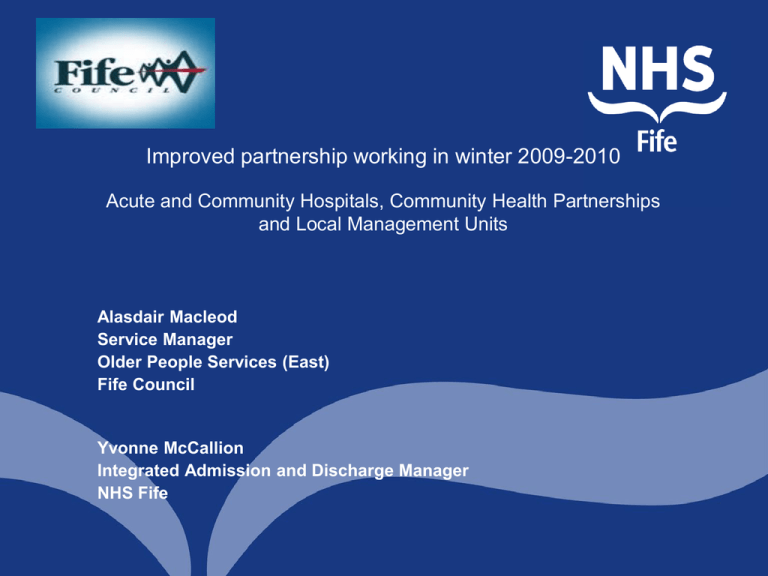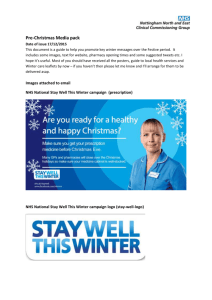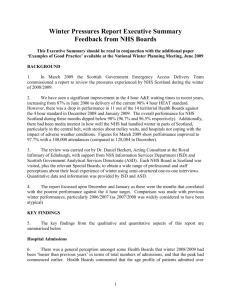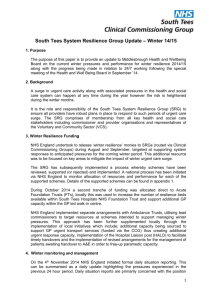Improved Partnership, Alasdair Macleod
advertisement

Improved partnership working in winter 2009-2010 Acute and Community Hospitals, Community Health Partnerships and Local Management Units Alasdair Macleod Service Manager Older People Services (East) Fife Council Yvonne McCallion Integrated Admission and Discharge Manager NHS Fife ‘Winter pressures in NHS Scotland 2008-2009’ report • ‘Health boards should ensure that their winter planning starts early and that the process includes Community Health Partnerships and Social Work Departments’ • ‘Integral to the winter plan should be the escalation plan. This should involve all stakeholders including Community Health Partnerships’ • ‘Health boards should undertake more accurate modelling over the festive period . . .’ • ‘The level of discharges over the holiday period should be improved’ Identified opportunities for improving partnership working • Part of the overall improvement in winter planning and partnership working following the recommendations in the ‘Winter pressures in NHS Scotland 2008-2009’ report • Early winter planning between health and social care • Improved communication – Predictive information – Escalation Identified opportunities for improving partnership working (cont.) • Development of infrastructure for escalation • Modelling activity to identify the required capacity at key points across the health and social care system • Increased discharge numbers of ‘complex’ patients over 2 week festive period – Restarting packages of care – New home care packages Improving the winter planning process • Planning commenced August using Local Management Units leads meeting as forum • Initial planning assumptions based on 7.9% increase in emergency admissions across NHS Scotland in December 2008 (data from SMR01 dataset compared to the 5 year monthly mean) Improving the winter planning process (cont.) • Challenging the system to identify how activity could be increased by 7.9% across the following areas – – – – – – – – Social work allocation Social work assessment Home care assessment Provision of home care packages Provision of equipment Delivery of equipment Funding for care home placement Intermediate care response to prevent admission and support early discharge Improving the winter planning process (cont.) • Discussions from August to December to agree how information should be shared and what the escalation arrangements should be – When? – Why? – Who? Key Planning • Direct access to private home care providers during festive period for patients requiring less than 10hours per week • Single point of access to social care over the festive period with voluntary cover from senior social care staff • Home care assessment and provision availability to both acute sites on 29th, 30th and 31st December Key Planning (cont.) • Daily teleconferencing commencing 21st December – end of January including social care and NHS staff (acute and community) – Daily SITREP’s from Operational Division detailing acute capacity / patients in delay and 4 hour performance – Weekly SITREP’s from CHP detailing community capacity • Direct access by NHS staff to available respite beds for patients awaiting complex care packages • Flexible use of community hospital beds including GP beds • Direct access by NHS staff to choice of care home if vacancies arise over festive period Impact of improved partnership working • 18 patients discharged over the festive period using resources not previously available QMH and VHK 4 Hour Performance December - January 2008/09 and 2009/10 100% 95% 90% 2008/2009 85% 2009/2010 80% 75% 70% 01/12 - 07/12 08/12 - 14/12 15/12 - 21/12 22/12 - 28/12 29/12 - 04/01 05/01 - 11/01 12/01 - 18/01 19/01 - 25/01 26/01 - 01/02 Lessons learned • Time taken to plan supported the development of improved relationships • Requirement for year round whole system escalation plan – not just 2 weeks • Need to focus on improving partnership working all year round – not just for 2 weeks • Review use of teleconferencing – improved structure of calls • Importance of continuing to build on the success of 2009-2010 to agree and develop new pathways and models of care











